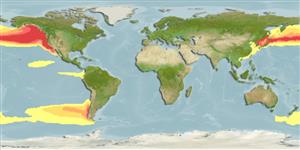>
Stomiiformes (Lightfishes and dragonfishes) >
Stomiidae (Barbeled dragonfishes) > Melanostomiinae
Etymology: Tactostoma: There is two interpretations; Greek, taktos, -e,-on = put in order + Greek, soma = body; or latin, tactus = touch, sense of touch + Greek, soma = body (Ref. 45335).
Environment: milieu / climate zone / depth range / distribution range
Ecologia
marino batipelagico; distribuzione batimetrica 30 - 2000 m (Ref. 28981). Deep-water; 66°N -
Northwest Pacific: Japan (Ref. 559); Kamchatka and Kuril Islands (Ref. 41668). Eastern Pacific: Bering Sea (Ref. 265) and the Gulf of Alaska to southern California, USA (Ref. 2850), southwards to central Baja California (Ref. 35904). Reported from Chile.
Length at first maturity / Size / Peso / Age
Maturity: Lm ?, range 30 - ? cm
Max length : 34.3 cm TL maschio/sesso non determinato; (Ref. 4925)
Spine dorsali (totale): 0; Raggi dorsali molli (totale): 14-18; Spine anali 0; Raggi anali molli: 19 - 22; Vertebre: 79 - 82. Jet black all over except for the dark gray on the posterior part of the lower jaw; when the thin epidermis is rubbed off, as is difficult to avoid, the dermis shows lead gray; young rich brown in color (Ref. 6885).
Mesopelagic migrating into epipelagic at night (Ref. 35904). Oviparous, with planktonic eggs and larvae (Ref. 35904).
Eschmeyer, W.N., E.S. Herald and H. Hammann, 1983. A field guide to Pacific coast fishes of North America. Boston (MA, USA): Houghton Mifflin Company. xii+336 p. (Ref. 2850)
IUCN Red List Status (Ref. 130435)
Threat to humans
Harmless
Human uses
Informazioni ulteriori
BibliografiaAcquacolturaProfilo di acquacolturaVarietàGeneticaElectrophoresesEreditarietàMalattieElaborazioneNutrientsMass conversion
CollaboratoriImmaginiStamps, Coins Misc.SuoniCiguateraVelocitàModalità di nuotoArea branchialeOtolithsCervelliVista
Strumenti
Special reports
Download XML
Fonti Internet
Estimates based on models
Preferred temperature (Ref.
123201): 0.3 - 6.7, mean 3.7 °C (based on 150 cells).
Phylogenetic diversity index (Ref.
82804): PD
50 = 1.0000 [Uniqueness, from 0.5 = low to 2.0 = high].
Bayesian length-weight: a=0.00093 (0.00036 - 0.00241), b=3.06 (2.83 - 3.29), in cm total length, based on LWR estimates for this (Sub)family-body shape (Ref.
93245).
Trophic level (Ref.
69278): 4.2 ±0.0 se; based on diet studies.
Generation time: 3.3 ( na - na) years. Estimated as median ln(3)/K based on 1
growth studies.
Resilienza (Ref.
120179): Medio, tempo minimo di raddoppiamento della popolazione 1.4 - 4.4 anni (K=0.3).
Fishing Vulnerability (Ref.
59153): Low to moderate vulnerability (33 of 100).
